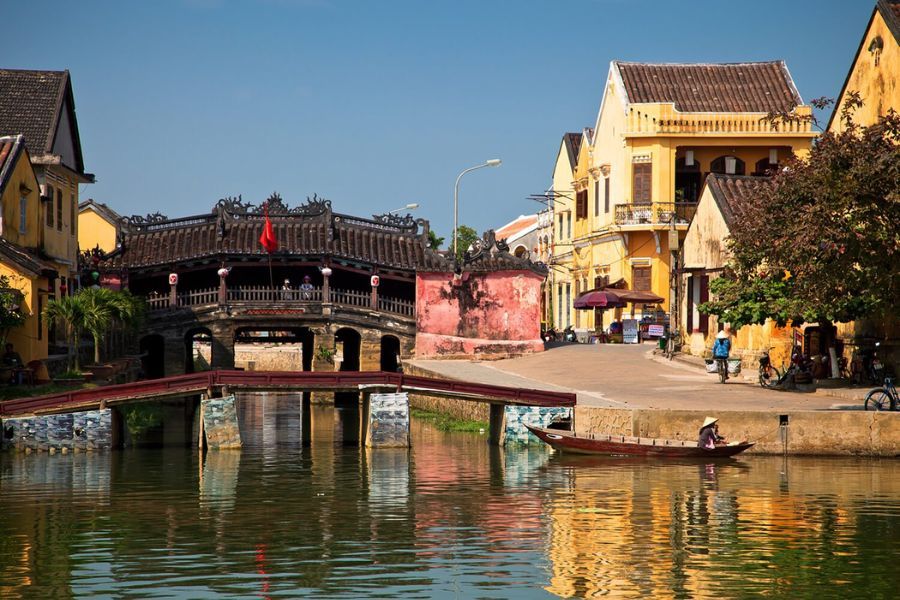Hoi An To Hanoi Complete Journey With Transport And Useful Advice
Traveling from Hoi An to Hanoi takes you from the lantern-lit charm of central Vietnam to the vibrant capital in the north. Many visitors choose this journey to enjoy both ancient heritage and modern city life.
Table of Contents
ToggleOverview Of Hoi An to Hanoi
Hoi An and Hanoi are two distinct parts of Vietnam, which is even more so when speaking of central and northern Vietnam. To the centre, Hoi An warmly welcomes tourists with its softly lit streets, calm river cafes, and relaxed lifestyle. As you head north, the coastlines transform into rich plains, which are home to old towns and bustling traditional markets.

On the other hand, Hanoi comes with the opposite. The capital is filled with a lot of history as well as the sounds of buzzing scooters, street shops, a blend of traditional music, and even vendors’ calls. After spending days in Hoi An, travelling to Hanoi enables you to immerse yourself in a place in ancient and modern Vietnam, which is a strong contrast to the places you have visited.
How Far Is It From Hoi An to Hanoi?
About 800 to 820 kilometers by road, Hoi An and Hanoi are fairly close together. Since Hoi An lacks an airport or a rail station, the majority of travelers pay perfect attention to Da Nang (approximately 30 km) and head north afterwards. The overall time of transport is considerable, depending on the pathway and transport mode.

When flying an aircraft, the route between Da Nang and Hanoi only takes a little over 1 hour and 20 minutes, but when it comes to airport transfers and check-in time, you need to count on an additional few minutes. The journey takes 15 to 18 hours by bus or sleeper coach. Via train, the trip between Da Nang and Hanoi should take approximately 16 to 17 hours, with more time possible should you decide to further explore the highlands of the north.
How to Travel From Hoi An to Hanoi?
Making the long journey north can be done in several ways, each with its own balance of time, cost, and comfort. Travelers can choose the option that best matches their schedule and style.
By Motorbike
For the more daring travellers, motorbiking all the way from Hoi An to Hanoi certainly is an adventurous pick. The route is more than 800 kilometers and takes you through a variety of sights, starting from central beaches to the foggy mountains of the north. Completing the journey on a bike allows you to take a break whenever you want, to fishing villages, to hidden twists of the passes, and rice fields.
The reward is the freedom and immersion that come with navigating a new city on your own, but the freedom doesn’t come without its challenges. Traffic on major highways can be grueling; the weather in Vietnam is notorious for its swift changes. This mode of travel, unless backed by strong riding experience and ample time, is best left for lightly-traveling, intrepid backpackers.

| Aspect | Details |
| Route | Route 1: From Hoi An → Da Nang → Hue → Dong Hoi (Quang Binh) → Vinh (Nghe An) → Ninh Binh → Hanoi. This is the fastest and most direct road, running along National Highway 1A. You will encounter many towns and services along the way, but also heavy traffic
Route 2: Hoi An → Da Nang → Hue → A Luoi → Khe Sanh → Phong Nha → Tan Ky (Nghe An) → Hoa Binh → Hanoi. This route follows the inland Ho Chi Minh Highway, quieter than QL1A, and takes you through mountains, forests, and ethnic minority regions Route 3: Ride north on QL1A to Hue, then switch to the Ho Chi Minh Highway to Phong Nha. From there, return to QL1A near Vinh and continue to Hanoi. This mix combines coastal scenery with mountain landscapes |
| Distance | Hoi An to Hanoi distance is 820 km via QL1A, up to 1,000 km on the Ho Chi Minh Highway |
| Travel Time | 2 – 3 days if you ride long hours, but most travelers take 4–5 days with overnight stops |
| Suggested Stops | Hue: You can explore the Imperial City and enjoy dinner by the Perfume River
Phong Nha: It is worth stopping to see the caves of Phong Nha–Ke Bang National Park Ninh Binh: Many travelers take a boat trip through Trang An or Tam Coc, much like exploring the highlights in Hoi An before heading north Thanh Hoa: The countryside here offers rice fields and peaceful villages, a good place to rest |
By Bus or Minivan
Taking the Hoi An to Hanoi bus is among the most budget-friendly and straightforward ways to cover the distance. Since you don’t have to make multiple transfers, you can board the bus in Hoi An or Da Nang and disembark in Hanoi, which enables many travelers to opt for this mode of traveling. The vans and minibuses are quite popular as well, having several departures each day, which makes planning your trip quite easy, even during the busy season.
The trip is usually long, mostly conducted at night, and the level of comfort largely depends on the service you choose. More passengers are crammed into standard sleeper buses, while limousine minivans transport fewer customers and offer larger seats along with gentler rides. If you’re on a budget, buses are the way to go, but if you want to get a decent amount of rest and comfort during your travel, minivans are worth the premium.

| Vehicle Type | Estimated Price (USD/VND) | Travel Time | Notes & Tips |
| Standard Sleeper Bus | Around $16 – 23 (~400,000 – 550,000 VND) | Approximately 15 – 18 hours | Very economical and widely available. Expect frequent stops for toilet and food breaks; seating can be tight. |
| VIP/Luxury Sleeper Bus | Around $30 – 40 (~700,000 – 900,000 VND) | About 16 hours | Offers full-flat beds with fewer passengers, better privacy, and often hotel pickup/drop-off. Comfort is noticeably higher. |
| Limousine Minivan | Typically $25 – 35 (~600,000 – 800,000 VND) | About 15 – 17 hours | Fewer seats, spacious reclining seats, often include hotel transfers, USB ports, and occasionally Wi-Fi. Ideal for those who value comfort on long rides. |
By Private Car
The ride in a personal vehicle between Hoi An and Hanoi is the way to enter a comfort zone as soon as you leave your hotel. You could have a break by the side of the road, have a stretch of your legs at a mountain pass, or even pull over and take a photo of the landscape. However, when it comes to families traveling with children or groups of friends who appreciate privacy and time, it can be very much worth it.

| Vehicle Type | Estimated Price (USD & VND) | Notes & Tips |
| 4-Seater Sedan | Around $90 – 100 (~2.4 – 2.6 million VND/day) | Ideal for small groups or couples with light luggage. Includes driver and fuel for a full day. |
| 7-Seater SUV / MPV | Around $100 – 110 (~2.8 – 3.2 million VND/day) | Better for families or groups with more luggage. Offers more space and comfort. |
| 16-Seater Van | Around $110 – 120 (~3.2 – 3.5 million VND/day) | Best for larger groups who need room and want to split costs. |
| Local Hoi An Private Car (Sedan) | Around $60 (~1.4 – 1.6 million VND) | A cost-saving local option if you’re departing from Hoi An. Includes driver, petrol, tolls, and bottled water—enough for a comfortable day trip. |
By Train
Those customers who appreciate taking the time for a journey, then one will not forget the Hoi An to Hanoi train. The trains leave the adjacent Da Nang and follow the coast of Vietnam until they reach the capital. On the road, you will encounter fishing villages, rice paddies, and mountain landscapes slowly evolving with every province. For many travelers, this slow ride becomes a highlight of their Vietnam trip, as no flight can give you such views.
The journey is lengthy, nearly a day on the rails, and yet there are a number of cabin options that make it workable. Daytime rides are appropriate for sitting in seats, whereas a sleeper berth enables you to sleep overnight. Its prices are affordable, and the rhythm of the train helps one relax more easily, socialize with other inhabitants, or just read a book until one can see Hanoi.

| Aspect | Details |
| Travel Time | About 16 – 18 hours, depending on the train schedule. Delays can occur, especially in the rainy season. |
| Cabin Types | Hard seat: Cheapest option, but very basic and uncomfortable for long rides.
Soft seat (AC): Air-conditioned and cushioned, better for daytime trips. Hard sleeper (6-berth cabin): Affordable overnight option with shared berths. Soft sleeper (4-berth cabin): More privacy and comfort, suitable for families or travelers wanting proper rest. |
| Estimated Price | From 400,000 – 700,000 VND (~20 – 30 USD), depending on seat type and booking time. |
| Best For | Travelers who prefer a slow but scenic journey, enjoy countryside views, or want to sleep overnight in a berth instead of sitting through the night. |
| Notes | Tickets can be booked online through platforms like 12go.asia, bought at Da Nang Railway Station, or arranged via travel agencies. Foreign travelers should carry passports. Bringing water, snacks, and motion sickness pills is recommended. |
By Flight
The Hoi An to Hanoi flight (route via Da Nang) has earned the rapid ranking of the fastest of all travel options. It only requires a little more than an hour to get to Hanoi from the airport, as opposed to buses or trains. For travellers with a tight schedule, flying will save more energy and allow more time to travel in the capital or even further north to sites such as Sapa or Ha Giang.

| Aspect | Details |
| Flight Duration | Around 1 hour 20 minutes from Da Nang (DAD) to Hanoi (HAN). Add 45 – 60 minutes to transfer from Hoi An to Da Nang Airport. |
| Airlines | Vietnam Airlines, Vietjet Air, Bamboo Airways. Multiple flights daily. |
| Estimated Price | From 800,000 – 1,800,000 VND (~35 – 75 USD), depending on booking time and promotions. |
| Airports | Departure: Da Nang International Airport (DAD). Arrival: Noi Bai International Airport (HAN). There is no airport in Hoi An. |
| Best For | Travelers who value speed and comfort, or those with limited time who want to maximize sightseeing in Hanoi. |
| Notes | Book early during peak seasons for better fares. Allow extra time for airport check-in and luggage. From Hanoi’s Noi Bai Airport, it takes about 45 minutes by taxi or shuttle to reach the Old Quarter. |
Tips For Traveling From Hoi An to Hanoi
An over 800-kilometer trip isn’t a quick jump, so a couple of useful preparations can help make the trip easier and much more enjoyable. This commentary is taken from what many travelers face on the road.

- Buses and trains typically arrive in Hanoi between 5-6 am, so book an early check-in hotel in advance, so you don’t have to wait at the reception.
- Summer thunderstorms in central Vietnam can slow trains and buses down; it’s best to have a buffer day in your schedule to enjoy Hoi An at its best.
- Flight and train tickets sell out quite quickly during Tet and other holidays; it is very important to book at least two weeks in advance.
- Traveling by bus is not very comfortable on long trips, as you can sometimes be crammed in with huge suitcases as well; if you have large bags, you would be best to go on trains or flights.
- Ninh Binh or Phong Nha stopovers break the trip into two shorter legs, and you get the chance to see more amazing places.
- Noi Bai Airport is around 30-45 minutes from the Hanoi Old Quarter, and so a pre-booked transfer saves on the time when you arrive and avoids haggling and stress.
Final Thoughts
Hoi An charms with quiet nights by the river, while Hanoi stirs with the constant hum of its streets. The stretch between them is long, yet that very distance makes the journey feel like a story unfolding. Some travelers want the quickest route, others enjoy the slow rhythm of the road, but in every case, the contrast between the two cities is the real reward. Seni World can help smooth out the details, so the focus stays on the experience itself.











